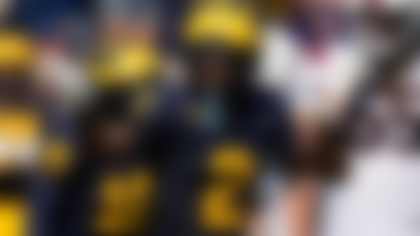Linemen often joke that holding happens on every play, but it doesn't get called.
That might change soon.
The NFL is considering a plan for the 2014 preseason that would add an eighth official to focus on interior line play, the league's head of officiating, Dean Blandino, said in an interview Thursday. The extra official -- who would line up in the offensive backfield with the referee and umpire -- would be added on an experimental basis, and would not be deployed in the 2014 regular season. The officiating department and Competition Committee want to see if an eighth official could improve the consistency of the calls involving play between the tackles enough to merit permanently expanding each game's seven-person officiating crew.
The Competition Committee will decide whether or not to go forward with this preseason experiment during ongoing meetings in Naples, Fla.
It is not the first time the NFL has pondered such a move. In the preseasons of 2010 and 2011, the league added an eighth official -- called the deep judge because he lined up about 25 yards downfield, essentially behind the deepest receiver -- to test whether an additional body would give the crew better coverage of the four- and five-receiver personnel packages that are now widely used. Blandino said that move did help, but the official was lined up so far from the line of scrimmage that he could not assist on shorter passes or runs, and so he did not become a permanent fixture. Essentially, the deep judge did not provide enough of a benefit that the league felt it was imperative to add one for good.
This year's addition could also address an unintended consequence of the NFL's decision to move the umpire from the defensive side -- they used to line up about 5 yards from the line of scrimmage, just behind the linebackers -- to the offensive side. The goal of that move was to improve safety for the umpires, who do not get knocked down nearly as much as they once did now that they're in the offensive backfield. However, coaches and players have long been concerned that the shift resulted in the view of defenders' hands being blocked, giving defenses an advantage in the trenches. Adding another official to focus on the line play might help.
"So we've been thinking about different places," Blandino said in a telephone conversation from the Competition Committee meetings. "We feel we can cover the receivers downfield because we have five officials there. The history and evolution of the game, we went from five to six to seven (officials). It's more of a wide spread, more passing game. It's not 3 yards and a cloud of dust. There is just more space to cover. We don't feel like we're missing more than we have in the past, but we have to stay ahead of the curve. Would adding another set of eyes help us?"
Battista: Jerry Jones' impact

A quick decision to boost the size of the officiating crew for good is not guaranteed; the idea of this preseason trial is so new that one member of the committee did not even know about it earlier this week. The Competition Committee would review tons of film and data to determine any changes in the number of fouls -- and whether officials had a better look at them or not -- before making such a recommendation.
The NFL last added an official -- going from six to seven -- in 1978, before the onset of the passing revolution that would eventually spread the field and tax the speed and eyesight of those who are supposed to be enforcing the rules. In 1978, teams averaged 64.6 offensive plays and 26.4 passing attempts per game -- that means just 40.9 percent of offensive plays were passes, according to statistics compiled by ProFootballReference.com. In 2013, an average of 54.5 percent of all offensive plays were passes.
Adding an official would be no small undertaking. It would mean hiring at least 17 new officials to fill the spots, although Blandino said he feels that there are enough qualified officials who have been training for NFL jobs in the pipeline.
"We wanted to make sure the benefit was there," Blandino said.
The experiment would come at a time when other officiating changes are being contemplated, as the rule book becomes more detailed and officials also are charged with such responsibilities as watching out for players who have sustained hits to the head. Another potential duty: The Competition Committee will discuss making racial slurs a point of emphasis in such a way that their use would result in a 15-yard penalty. The league already has guidelines in place governing abusive language; Blandino said a point of emphasis in 2013 that centered on taunting and unsportsmanlike conduct resulted in a four-fold increase in taunting penalties over 2012.
Consistency has become an officiating buzzword in recent weeks -- Commissioner Roger Goodell spoke about it at his state of the league address before Super Bowl XLVIII -- particularly after a season that included what seemed to be weekly controversy and culminated with what the NFL admitted was a blown call, a mistake that might have cost the Pittsburgh Steelers a playoff spot. Among other things, the Competition Committee also is expected to spend time this week discussing a centralized replay system, which would take reviews out of the hands of the on-field officials and bring them into one place, thus -- the league hopes -- making review calls more uniform. Blandino said it is unclear if the replay system could be fully centralized in time for the 2014 season.
"There is a lot on their plate," Blandino said of the officials. "We're aware of that when we make rules changes -- we think about unintended consequences. I don't know if necessarily adding another set of eyes solves all of that. We have to manage that with the Competition Committee, to make sure rules can be officiated, and that we're not just making changes for plays that happen once every 10 years."
Follow Judy Battista on Twitter @judybattista.












